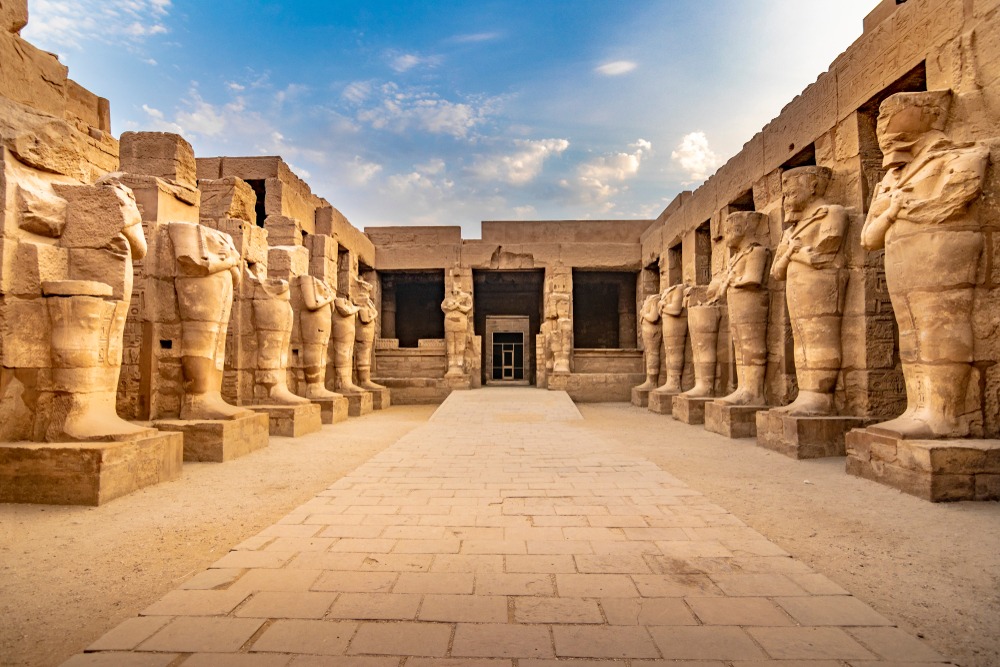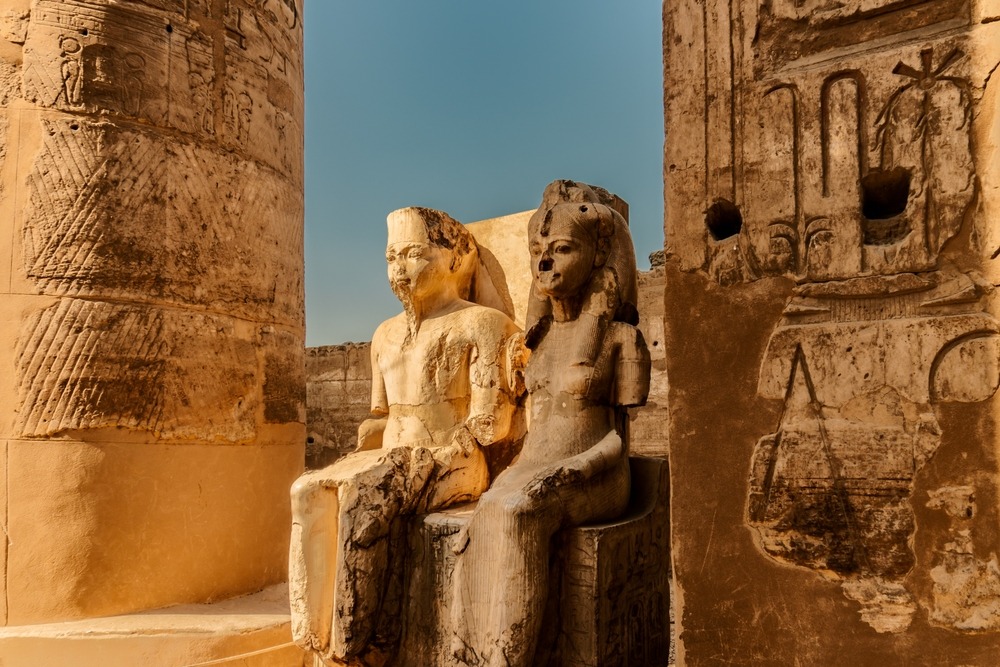Karnak: The Eternal Sanctuary of Amun-Ra
History of Karnak – The Spiritual Heart of Ancient Egypt
Nestled on the east bank of the Nile in modern-day Luxor, Karnak was not a city of residents, but a city of gods. It was the center of religious and ceremonial life in Ancient Thebes, the capital of Egypt during the Middle and New Kingdom periods. What remains today is the Karnak Temple Complex—the largest religious structure ever built by man—dedicated primarily to Amun-Ra, king of the gods, and his divine family: Mut, his consort, and Khonsu, their son.
The earliest foundations of the Karnak temples date to the Middle Kingdom (c. 2055–1650 BCE) under Pharaoh Senusret I of the 12th Dynasty. However, Karnak’s golden age came during the New Kingdom (c. 1550–1070 BCE), particularly under powerful pharaohs such as Thutmose III, Hatshepsut, Seti I, and Ramses II, who all contributed to the massive expansion of the complex.
At its peak, Karnak was a sacred site with dozens of temples, obelisks, pylons, and shrines sprawling over 250 acres. It was the site of grand religious festivals, most notably the Opet Festival, in which the sacred barques (boats) of Amun, Mut, and Khonsu were carried from Karnak to Luxor Temple along the Avenue of Sphinxes.
The structure was built incrementally over more than 1,500 years, with each successive pharaoh leaving his mark. Obelisks were erected to honor deities, courtyards expanded to accommodate pilgrims, and sacred lakes dug for purification rituals.
During the Late Period and Ptolemaic era, Greek rulers continued to maintain Karnak, blending Egyptian and Hellenistic styles. After the spread of Christianity in Egypt, many temples were defaced or repurposed. By the Arab conquest of Egypt in the 7th century CE, Karnak had already begun its descent into ruin, buried under layers of Nile silt and history.
Rediscovered by European explorers in the 18th and 19th centuries, Karnak became a centerpiece of Egyptology. Today, it remains a UNESCO World Heritage Site and a must-visit destination for anyone interested in the grandeur of ancient civilizations.

Top 25 Attractions in and Around Karnak
Within the Karnak Temple Complex
1. Great Hypostyle Hall
The most iconic structure within Karnak, this hall features 134 massive sandstone columns arranged in 16 rows. Some columns soar over 70 feet, and their carved reliefs remain remarkably preserved. This hall alone covers more space than some entire cathedrals.
2. First Pylon
The grand entrance to Karnak, begun during the 25th Dynasty, is the largest pylon in Egypt. Although unfinished, it sets the tone for the monumental scale inside.
3. Sacred Lake
A vast rectangular basin used for ritual purification, still filled with water today. Priests would bathe here daily, and ceremonies involving sacred boats were held on its surface.
4. Obelisk of Hatshepsut
One of the tallest surviving ancient obelisks, it was erected by Queen Hatshepsut and dedicated to Amun-Ra. Its inscriptions honor her divine birth and power.
5. Obelisk of Thutmose I
Smaller than Hatshepsut’s but still imposing, this granite monument celebrates the military campaigns of one of Egypt’s most successful warrior-pharaohs.
6. Second Pylon
Built by Horemheb and finished by Ramses I and II, this gateway leads to the Hypostyle Hall and is flanked by colossal statues and fragmented blocks.
7. Festival Hall of Thutmose III (Akh-menu)
A unique structure used for festivals and ceremonies, featuring unusual architecture and a “botanical garden” of carved exotic plants and animals the pharaoh encountered abroad.
8. Temple of Ptah
Located in the northern precinct, this smaller temple is dedicated to the Memphite god Ptah, who represents creation and craftsmen.
9. Temple of Khonsu
A well-preserved example of New Kingdom architecture, dedicated to the moon god Khonsu, son of Amun and Mut. It features pylons, courtyards, and beautifully painted ceilings.
10. Temple of Mut
South of the main complex, this temple honors the goddess Mut, consort of Amun. It is currently under excavation and features hundreds of lion-headed statues of the goddess Sekhmet.
11. Avenue of Sphinxes (Dromos)
This ceremonial processional road lined with ram-headed sphinxes once stretched from Karnak to Luxor Temple. Many of the sphinxes still guard the entrance.
12. Temple of Amun-Ra
The central temple and spiritual core of Karnak. Multiple pylons, chapels, courts, and shrines dedicated to Amun dominate this section.
13. Red Chapel of Hatshepsut
Originally a barque shrine, this structure displays reliefs of the queen performing rituals. It was dismantled in antiquity and reconstructed from rediscovered blocks.
14. White Chapel of Senusret I
One of the oldest structures, this Middle Kingdom shrine showcases fine hieroglyphs and is an excellent example of early Karnak architecture.
15. Temple of Ramses III
A smaller temple built in the traditional style, featuring scenes of the king defeating enemies and honoring Amun.
16. Temple of Amenhotep II
A hidden gem within the complex, with partially preserved walls showing offerings to Amun.
17. Temple of Osiris Heka-Djet
Dedicated to a rare form of the god Osiris, this temple lies in the southern part of the complex and features unique theological symbolism.
18. Kiosk of Taharqa
A Nubian king of the 25th Dynasty, Taharqa constructed this elegant structure with ten papyrus-shaped columns—some of which still stand.
Nearby Attractions in Luxor (Ancient Thebes)
19. Luxor Temple
Connected to Karnak by the Avenue of Sphinxes, this temple was built by Amenhotep III and expanded by Ramses II. It was a center for the Opet Festival and features colossal statues and obelisks.
20. Avenue of Sphinxes
Recently reopened, this 1.7-mile ancient processional path directly connects Luxor Temple and Karnak, once used during major religious festivals.
21. Luxor Museum
An excellent museum featuring artifacts from Karnak, including the famous statue of Thutmose III, pottery, jewelry, and mummies.
22. Mummification Museum
A small but fascinating museum explaining the mummification process, complete with tools, coffins, and preserved human and animal remains.
23. West Bank of the Nile (Valley of the Kings)
Though technically across the river from Karnak, the Valley of the Kings is part of ancient Thebes and complements the religious function of Karnak with royal tombs, including that of Tutankhamun.
24. Valley of the Queens and Temple of Hatshepsut
Also on the West Bank, the funerary temple of Queen Hatshepsut is a terraced architectural marvel, while the Valley of the Queens holds richly decorated tombs.
25. Colossi of Memnon
Two massive statues of Amenhotep III that once guarded his mortuary temple. These ruins greet visitors entering the West Bank and have stood for over 3,000 year

Karnak is more than just a temple complex—it is a testament to the architectural, spiritual, and artistic legacy of Ancient Egypt. From its colossal pylons and mysterious sanctuaries to the lunar temples and lion-headed deities, every stone whispers stories of kings, gods, and timeless ceremonies. Whether you’re wandering beneath the towering columns of the Hypostyle Hall or standing at the banks of the Sacred Lake, Karnak offers a deeply immersive connection to the past. Together with the neighboring monuments of Luxor, it forms the soul of ancient Thebes—a place of awe, ritual, and eternal memory.
































